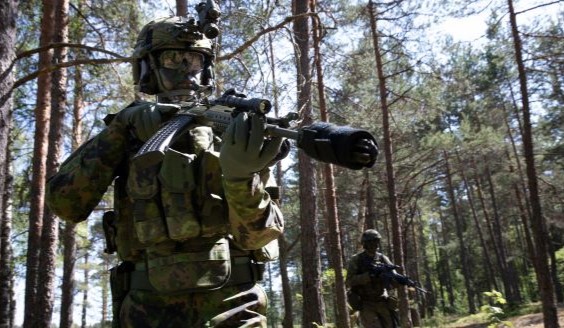
The Finnish Defence Forces will shift to using the NATO-standard calibres for new small arms, said an official press release on Tuesday.
The decision will improve the soldier’s operating capability, interoperability, and security of supply.
Over the past years, the Finnish Defence Forces have examined the characteristics necessary for small arms in the future. The analysis has also included examining the choice of calibres for new small arms.
Based primarily on capability requirements, the decision on the calibres enables developing the production capacity of national small-calibre ammunition, and continuing the preparations for procurement of new soldier-specific and force-specific small arms.
The new calibre for the soldier-specific weapon, the assault rifle, will be 5.56x45mm which meets the requirements set by the threat and operational environment.
The new calibres for the force-specific firearms will be 7.62x 51mm and 12.7x 99mm. The pistol calibre will continue to be 9x19mm.
The new calibres will be fielded progressively in conjunction with the small arms modernisation. The present small arms calibres (7.62x39mm, 7.62x53R, and 12.7×108 mm) will continue to be in service but with no extension procurement.
“While selecting the calibre, a number of factors were examined and considered. The decision was affected, among other, by capability requirements, soldier’s load, interoperability among allied nations, security of supply, and availability of ammunition, as well as national production capacity,” said Chief of Operations, Army, Brigadier General Sami-Antti Takamaa of the Army Command.
In a Finnish environment, the firing distances for small arms are nearly always less than 200 metres, and typically less than 100 metres. An assault rifle must be able to deliver effects up to 600 metres. The higher bullet velocity and flatter trajectory of the new calibre will increase the hitting probability, which is relevant when firing in an unspecified distance or to a moving target.
The smaller and faster 5.56x45mm bullet will more efficiently penetrate varying materials than a 7.62x39mm one in distances less than 200 metres. Additionally, less recoil, a flatter trajectory, and lower cartridge costs will make it easier to acquire shooting and marksmanship skills. As for the bullet’s gyroscopic stability (ricochet tendency), there is no significant difference between the current calibre ammunition and that of the new one.
The materiel load that the soldier carries has increased due to the fielding of night vision equipment, weapon-mounted special equipment, and new force protection kit.
The new calibre will reduce the combined mass of the firearm and ammunition and thus the soldier’s load in total.
“At present, the assault rifle and two-day ammunition weigh up to c. 8,9kg. By shifting to using a lighter weapon and calibre of ammunition it is possible to reduce this weight altogether 3,5kg. This will increase the soldier’s operating capability and enable carrying more cartridges,” said Brigadier General Takamaa.
The availability of the new-calibre ammunition is considerably better under normal and exceptional circumstances than that of the 7.62x39mm which is utilised on a very small scale in Europe.
In comparison, nearly all alliance and partner nations use and stockpile the NATO-standard ammunition, whose production capacity is also considerably higher in the West.
Alongside its better availability and reduced raw material need, the new cartridge will be less expensive to procure than its predecessor. Similarly, its logistic will be smaller due to it being lighter and requiring less packaging space.
“The war in Ukraine has demonstrated that the consumption of small arm cartridges is high. They must be readily stockpiled and also available during wartime. This is why it is important that nationally and in the Nordic countries we sustain production capacity for the small arms calibres that we use. The same calibre as that of our allies ensures using the same-calibre cartridges both in peacetime training exercises and under exceptional circumstances,” Takamaa added.
Targets that are in the distance of over 200 metres are mainly affected by fires of force-specific firearms: designated marksman’s rifles, machine guns, sniper rifles, and grenade launchers.
The calibres 7.62x51mm and larger enable penetrating target protections while firing in the distances of several hundred metres. The hitting probability of the larger-calibre ammunition is higher also in longer distances compared to the 5.56x45mm-calibre ammunition.
The Sniper Rifle M10 fielded this year uses the 8.6mm calibre, whereas the Rifle System 23 to be fielded next year will use that of 7.62x51mm. These weapons have been extensively tested, and their use case results have been good. The effective shooting distance of the weapons extends up to 1,400 metres. The Finnish Defence Forces already employ the Heavy Machine Gun 12.7mm, and its effective firing distance is up to 2,000 metres.
At least some of the machine guns to be procured will use 7.62x51mm-calibre cartridges, but all options will be examined. Machine gun fires enable providing force-level fire support effectively in the distance of hundreds of metres, and delivering effects to targets that require a number of hits.
The decision made now enables continuing the procurement preparations concerning the new soldier-specific and force-specific small arms. The small arms modernisation underway concerns alongside assault rifles also machine guns, semi-automatic sniper rifles, and M10 sniper rifles. The procurement of the weapons will last throughout the 2030s.
Next year marks the start of the field testing of the new 5.56mm-calibre assault rifles ordered from Sako for testing purposes.
The small arms modernisation will also involve that of the light machine guns. The Finnish Defence Forces have tested a number of alternatives, and the decisions on the machine guns will be made during 2026-2028.
- Finnish
- Army
- NATO-standard calibres
- New small arms
Source: www.dailyfinland.fi
